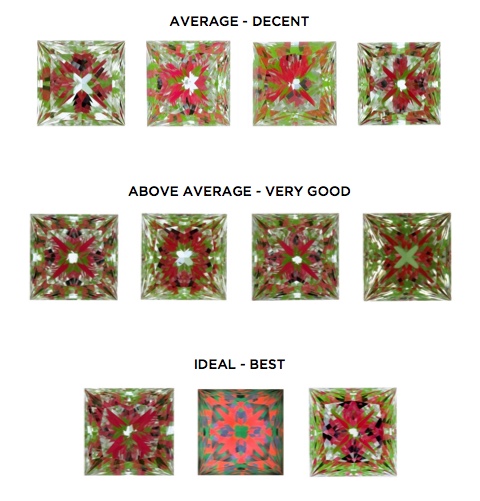The princess cut is a square shaped diamond created in the 1960’s by A. Nagy of London, but was popularized in the 1980’s by Betzalel Ambar and Israel Itzkowitz. It is often considered the most popular fancy shape to purchase.
The price‐per‐carat of a square princess cut diamond is usually slightly cheaper than that of round brilliant cut diamond because it retains about 80% of the rough, as opposed to the round, which retains only about 50% of the rough. A greater yield means a lower price! The ability to retain more crystal weight makes the princess shape most popular amongst diamond cutters and will mean that your 8 carat diamond ring will be significantly cheaper if you choose a princess cut than a round brilliant.
Why choose a princess cut diamond?
When looking at a princess cut face up, the crown surface area appears to look bigger than that of a round diamond. This is because the corner to corner measurement of a princess cut is 15% greater than the diameter of a round brilliant of the same weight. In reality though, the crown surface area of a princess cut is about 10% smaller than a round brilliant of the same weight.
The princess cut (along with the radiant cut) comes the closet to achieving the fire and brilliance of a round diamond. It is typically square in shape, with a length to width ratio of 1.05 or less. Of all of the square cuts, the princess is the only one that has corners. Because of this design, a princess cut diamond is much more susceptible to damage, so it must always be set with prongs that protect its four corners from chipping.
When choosing a princess cut, the rule of thumb is to avoid those with a table % that is greater than the depth %.
8 carat princess cut diamond cut guide
As the princess cut is a brilliant cut diamond, it requires precise proportions to ensure that light can enter the top of the stone, be reflected off the bottom facets and then back up through the table in the form of brilliant sparkle.
For this reason, the proportions of the diamond are extremely important. Poor proportions mean that light will be lost and the diamond won’t sparkle.
The table below shows our recommendation for proportions for a princess cut diamond:
IDEAL | EXCELLENT | VERY GOOD | GOOD | FAIR | POOR | |
|---|---|---|---|---|---|---|
| TABLE % | 62- 68 | 62 – 70 | 59 – 61 or 71 – 74 | 56 – 58 or 75 – 82 | 53 – 55 or 83 – 85 | < 53 or > 85 |
| DEPTH % | 64 – 75 | 58 – 63.9 or 75.1 – 80 | 56 – 57.9 or 80.1 – 84 | < 56 or > 84 | ||
| GIRDLE | Very Thin – Slightly Thick | Very Thin to Thick | Very Thin to Very Thick | Extra Thin to Extra Thick | ||
| CULET | None | Very Small | Small | Medium | > Medium | |
| L/W RATIO | 1.00 | 1.00 – 1.03 | 1.04 – 1.05 | 1.06 – 1.08 | > 1.08 | |
| CROWN HEIGHT % | 10 – 15% | 8.5 – 16.9% | 6 – 18% | 5 – 9.9% | 3 – 20.9% | < 3% or > 21% |
As with all brilliant cut diamonds, we recommend you select the highest cut quality you can. After all, what’s the point of a a significantly sizes diamond that doesn’t sparkle?
ASET & IDEALSCOPE
Both ASET and Idealscope images can help you to better exaluate the light performance of your diamond.
Both tools will reveal areas of light leakage in white, but an ASET reading contains more detailed information. Because of this, it is the preferred method for evaluating fancy cut diamonds. However, because of the idealscope’s simplicity, it is a more user-friendly tool for non-gemologists. All you need to know when reading an idealscope is that white areas represent light leakage (bad) and red areas indicate light return (good).
Check out these images below for examples of ASET and Idealscope readings for princess diamonds:


